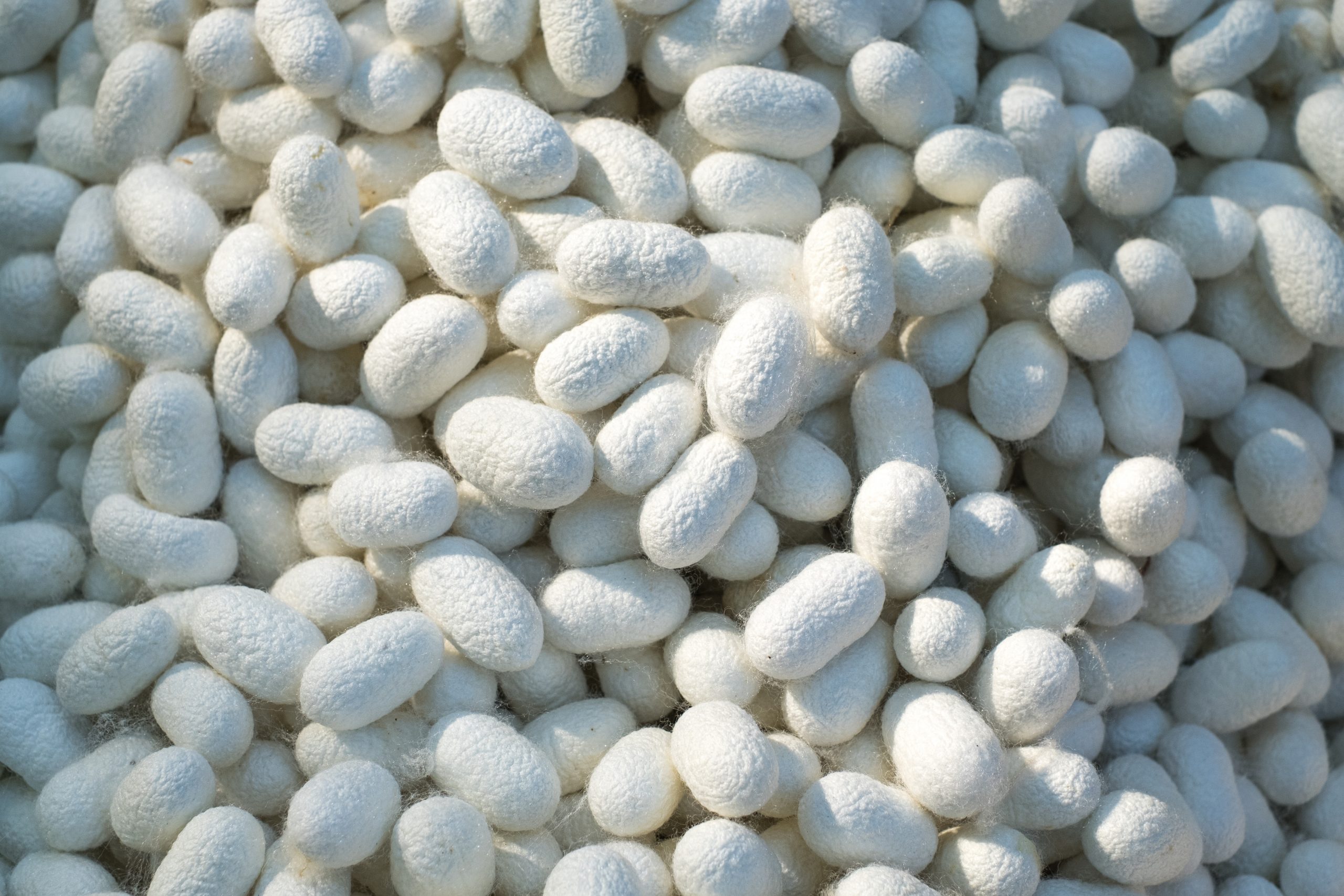MII’s recent report, What Makes Silk, Silk? Revisited expands upon the original 2021 version to bring you updated insights into the growing next-gen silk industry. It profiles 14 different innovators creating the next generation of silk. January 2024, Thomasine Dolan Dow, Director of Material Innovation and Design at MII, spoke with three of these pioneering companies which are each using different technologies to create silk-like filament fibers that not only mimic silk but have the potential to replace the polyester and nylon versions of silk prevalent in the current material landscape. Read on for the key takeaways from the discussion, or watch the recording below.
The Innovators
Our panelists were:
Martin Lankes, Senior product manager of fiber business at AMSilk. AMSilk makes a silk protein via bacterial fermentation. It is produced by genetically engineered microbes and spun into fiber. It is a high-performance filament fiber that is thinner and more delicate than traditional insect-produced silk. The fibers are biodegradable in marine, anaerobic and aerobic conditions and contain no petrochemicals. AMSilk is headquartered in Germany.
Shannon Parker is the Director of Industry Engagement and Impact Strategy at Circ. Circ’s textile-to-textile recycling regenerates cellulose from the cotton portion of polycotton textile waste to produce lyocell. They can produce filament fibers matching silk. Circ’s mission is to recycle global fashion waste into “like-new” materials, creating a circular economy and in the process reducing the need for petroleum, trees and other materials that are harvested from nature to manufacture clothes. Circ is headquartered in Danville, Virginia and they are a B-Corp.
Billy McCall is a polymer scientist and co-founder of Kintra Fibers. Kintra Fibers makes biosynthetic yarns.They use a fermentation process to fine-tune their yarn into a wide range of biosynthetic knit and woven textiles that perform like traditional technical fabrics, but they degrade like a natural fiber with no harmful effects on the environment. Some of the fabrics made with their fibers mimic lightweight woven silk taffeta and a knit with a cashmere-like handfeel. Kintra Fibers is headquartered in Brooklyn.
The art and science of scaling
The perennial challenge of scaling is something that faces all innovators. And the definition is fluid, also; there’s a large possible range when it comes to what it means to be scaled up.
“Regardless of if you have infrastructure or not built out, it’s a massive cash-burn,” said Billy McCall of Kintra Fibers. There are many inputs to consider and increase: raw material requirements, utilities, shipping and receiving costs. Purity in your formulation or process is key – tiny discrepancies become magnified at scale, and “[If] you get a bad batch, that’s a very large bad batch that’s a huge waste of money,” he added.
Shannon Parker of Circ was quick to highlight that scaling should be conceived of as a journey and not a destination, and a highly iterative one at that, with many different challenging facets (e.g. CapEx, matching existing assets in the industry like meeting minimum order quantities.)
For AMSilk, Martin Lankes echoed that scaling is one of the hardest parts of an innovator’s work and that even for an established innovator like AMSilk who has been around since 2008, their current level of scaling into tons is still a small amount in the larger context of the textile industry.
When should innovators start thinking about LCAs and Circularity?
During the process of testing and iterating on fibers and yarns, when is a good time to start considering end-of-life and circularity?
It’s different for every company. Some innovators like Kintra Fibers had it in mind before even getting into the lab – they wanted to know how many degrees of freedom their material could have at end-of-life.
“Figuring out what is the best system is something you can do quite easily just in a simple thought experiment, there’s a lot of data out there on specific chemistries [and] how people might treat them at the end-of-life,” Billy shared.
AMSilk shows a contrasting origin for an innovator, as they started out from a strongly performance-oriented mindset to create a man-made fiber that was as strong or stronger than silk but still a “super clean and pure protein fiber”. They then later pivoted to a fully biobased and fossil-free approach due to the growing tide of interest from consumers.
Textile Performance: Replicate the incumbents or forge a new class?
Silk and polyester have extremely high performance qualities. Are these innovators using that as a standard? Or do they try to operate in their own class of fiber and yarn?
The discussion highlighted the paradox between the inevitable losing battle of comparing your innovation to incumbent silk and polyester and yet the need to do so to measure technical and performance aspects. There was agreement that from a technical perspective, comparison is unavoidable, but from a marketing one, it is more beneficial to embrace being a distinct product that may have unique benefits way beyond the reach of the incumbents.
What are the end uses for these innovators’ yarns and fibers?
- Circ creates intermediary products, e.g. dissolved pulp or PET chips from recycled materials which drop into existing processes. They think of things in the framework of polyester or lyocell. There is a very small amount of lyocell filament made in the world, because it’s challenging to make, and any amount of contamination can cause a break in the filament. That Circ can produce it speaks to the quality of their fibers.
- AMSilk focuses on substituting silk in luxury fashion. They know they cannot compete with polyester/polyamide on price parity, so they position themselves among more luxurious fabrics like silk, cashmere and high-priced wool. They have good contacts within the automotive industry, which is looking to replace animal leather with high-value textiles.
- Kintra Fabrics targets luxury, ready to wear and athletic wear. They designed the scaling of their product so that they can reach parity with things like PET once they are at the 100K ton/year level. A huge benefit to their synthetic chemistry approach is that their resin and yarn is compatible with equipment used to create PET, but uses less energy due to lower production temperatures.
Co-Developments through Mill and Brand Partnerships
Mill partners help innovators towards the holy grail of being “plug and play” and brand partners help with the manufacturing process. Martin emphasized that despite AMSilk having many partnerships throughout the value chain, the most important and best ones were joint agreements with brands. These create a certain power and ease whereby the brand can confirm interest to the mills, who are in turn happier to be involved, and they can move “top-down along the value chain”. The best partnerships are value-aligned ones and good partners will help you along the scaling journey and are willing to work with the challenges, not just put you “in one of those existing boxes and compare you on cost,” said Shannon.
For more information on next-gen silk, download our What Makes Silk, Silk? Revisited 2023 report.
To get involved in our future webinars, check out our upcoming sessions here.

